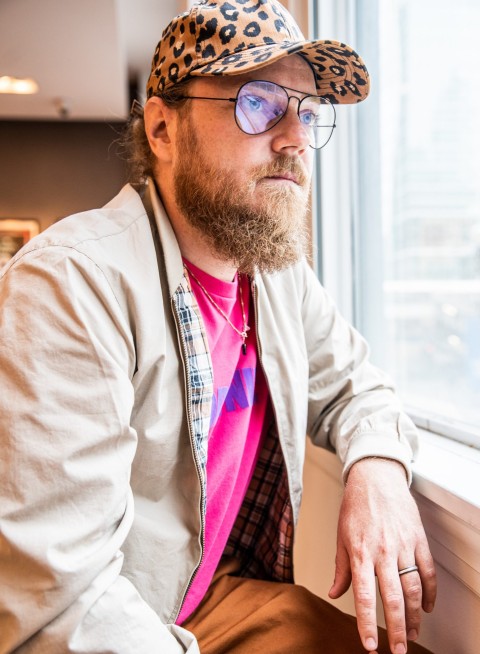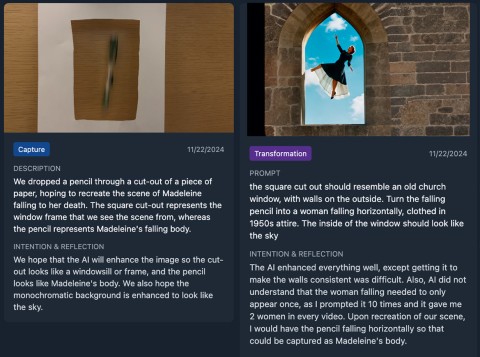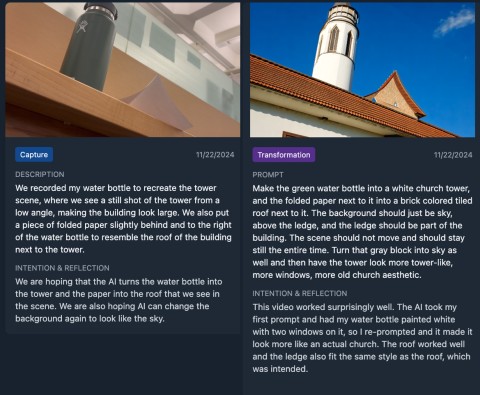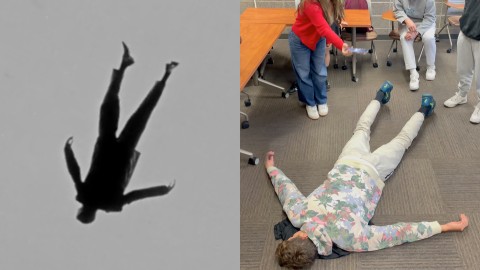
Jon Satrom is an Assistant Senior Instructional Professor and Associate Director of the Program in Media Arts and Design. Over the past few years, Satrom has worked with his colleagues in Cinema and Media Studies to develop the practice-based Media Arts and Design major and minor. He regularly teaches Core and Capstone courses and irregularly develops special topics courses within the areas of video games, realtime audio/video performance, creative computing, electronic sound, and glitch art. As a teaching artist, Satrom works to craft studio classroom experiences that foster experimentation, criticality, and "creative problem creating.” His recent courses include “AI + Video: Glitches, Promises & Slop,” “Performance as Event,” and “From Failure to Filter: S#bversions & E/olutions in Glitch Art.”
Tell us about vertigo.video. What is the goal for this assignment, and how does it contribute to the Media Aesthetics curriculum?
Vertigo.video is a workshop and corresponding website that I designed for the Media Aesthetics Core, piloted in seven sections in Autumn 2024. Instead of making an argument through research papers, we ask students to do so through creative means – in this assignment, through technology. Students perform close readings of Hitchcock’s 1958 film Vertigo, and Walter Benjamin’s “Art in the Age of Mechanical Reproduction.” Then, they choose from a list of possible scenes from the film, collaboratively re-enact and re-film their scene using their smartphones, and then input their footage into Runway, an AI tool that uses a video-to-video AI process to transform and reconstruct the footage. In addition to capturing their clips, students prompt the AI to change aspects like lighting and subject matter, and they can choose to reproduce, challenge, or comment on the film. In the process they learn practical aspects of filmmaking, such as framing, blocking, and isolating movement and gesture, alongside crafting prompts for an AI tool and critiquing the outputs by examining successes, failures, and the gaps between expectation and outcome.
To see examples of students’ work, please see: https://vertigo.video/scene-8/. At the top of the page you’ll see Vertigo’s original dream sequence. Below that you can see students’ group submissions, both their recreations of the scene and their transformations of it, complete with the prompt they used for the AI when they transformed a scene.

FIG 1: side by side of student captured video and transformed video via Runway (Enlarge Figure 1)
What teaching challenge did you want to address with this approach/technique?
The objective was to critically assess AI's role in art creation, understanding its potential and limitations in meeting artistic expectations. This workshop aimed to have students explore Walter Benjamin's "Art in the Age of Mechanical Reproduction" in practice, especially how AI [can challenge notions of originality and authenticity], and Benjamin’s response to revolutionary technology. Students also used modern technology, such as AI and smartphones, to analyze Hitchcock's innovative "Vertigo shot."


FIG 2 – screen capture of student reflections on vertigo.video (Enlarge Figure 2a) (Enlarge Figure 2b)
How do you assess students’ learning in the vertigo.video assignment?
We debrief the workshop together in class so that students can critically reflect on the experiences of using AI to create art. In doing this, we create space for what students often see as a forbidden fruit and an opportunity to learn its languages and processes, while also grappling with the reality that these systems are being deployed across our lives with little choice on our part. I wanted them to see that AI is a technology with the potential to help us view and make art in different ways, but to also be critical viewers and consumers of its output.
What is working well about what you’re doing, and why do you think it’s working?
Students responded well to the practice-based nature of this project, which is a common assignment structure in the Media Arts and Design Program. Making and creating things exercises a different set of skills that students need in order to articulate and express themselves in digital forms. They have to be creative and even get physical when they reenact the scenes from Vertigo (jump off tables, throw things down stairways, and run around filming with their phones) - not things that they get to do every day.

FIG 3 – students working on the assignment (Enlarge Figure 3)

FIG 4 – student image after in-class work (Enlarge Figure 4)
What changes do you hope to make to this practice in upcoming terms?
The project will inevitably shift as AI shifts. Last year’s workshop became a precursor to my AI + Video course in the spring of 2025. That course turned into a time capsule almost instantly: within a week of finals, students were emailing me that newly released video models had already made our assignments feel dated. That velocity is the reality we’re working in: the tools change so quickly they’re both outdated and novel at once. Looking ahead, I have revamped my AI+Video production course to engage more directly with how these systems are molding culture–for better or worse. I’m interested in how we might reclaim agency as users by experimenting, tricking, and outsmarting AI to unlock new aesthetics. At the same time, students must learn to use these technologies critically and responsibly, recognizing their potential harms to culture and the environment. My hope is that this kind of hands-on engagement continues in the Media Aesthetics Core. It’s at the core of the Media Arts & Design program, where students learn not only to make with new tools, but to critically shape the worlds those tools create.
FIG 5 – Maryam S. AI+Video project from Spring 2025